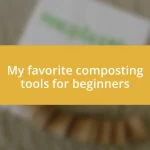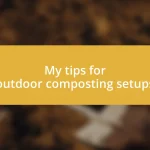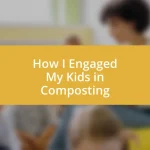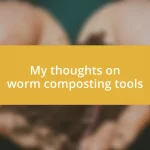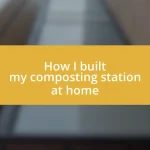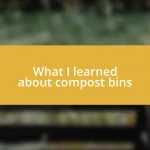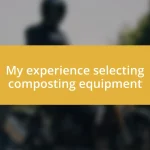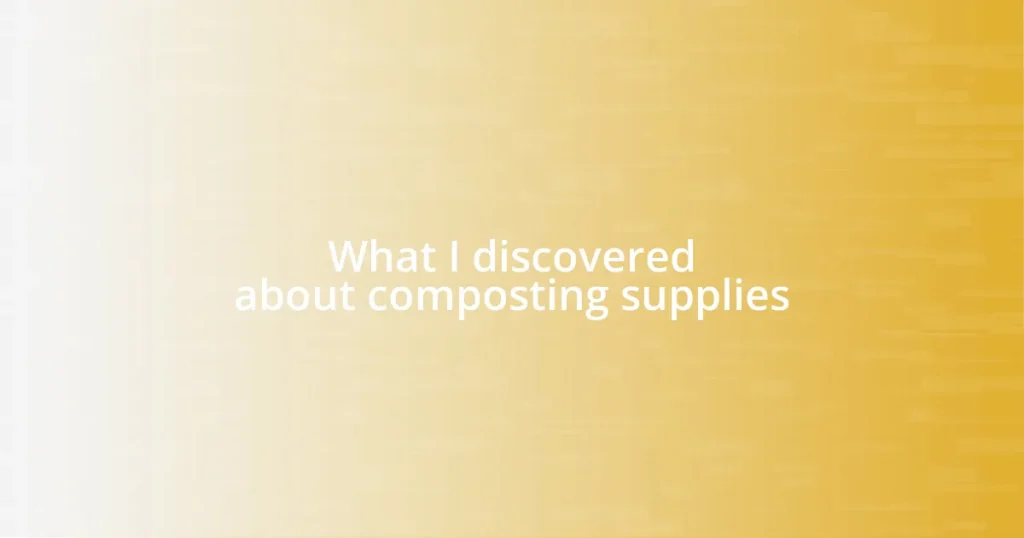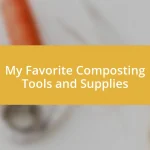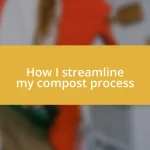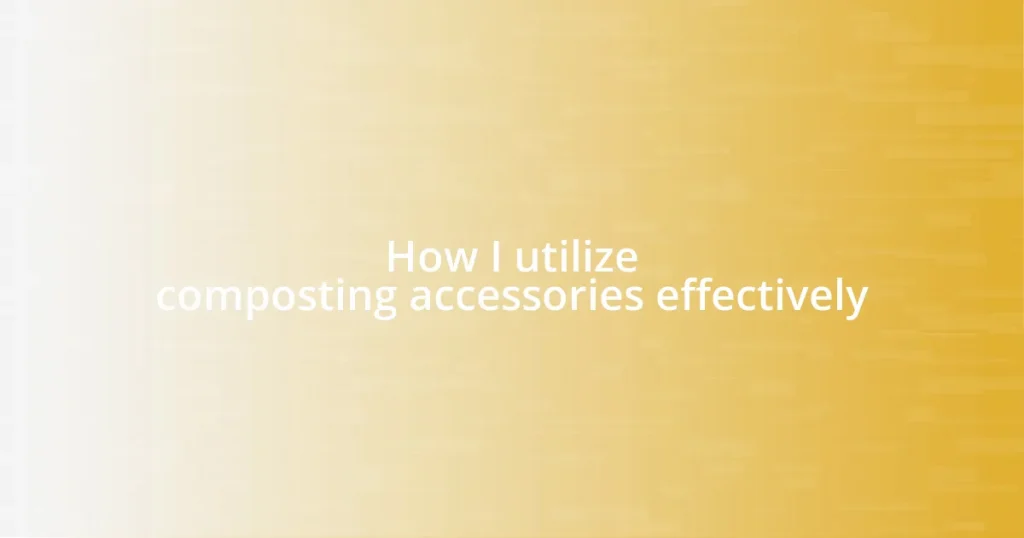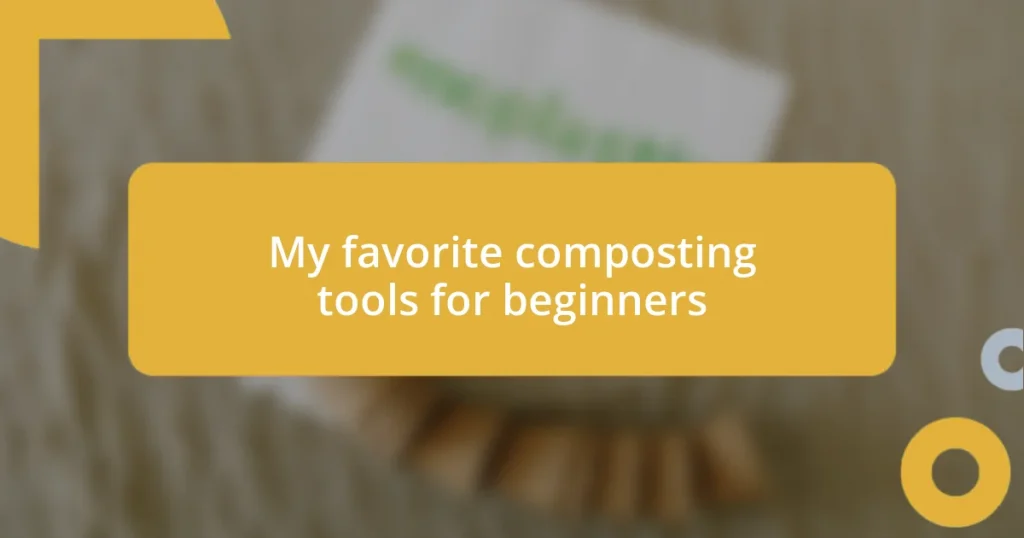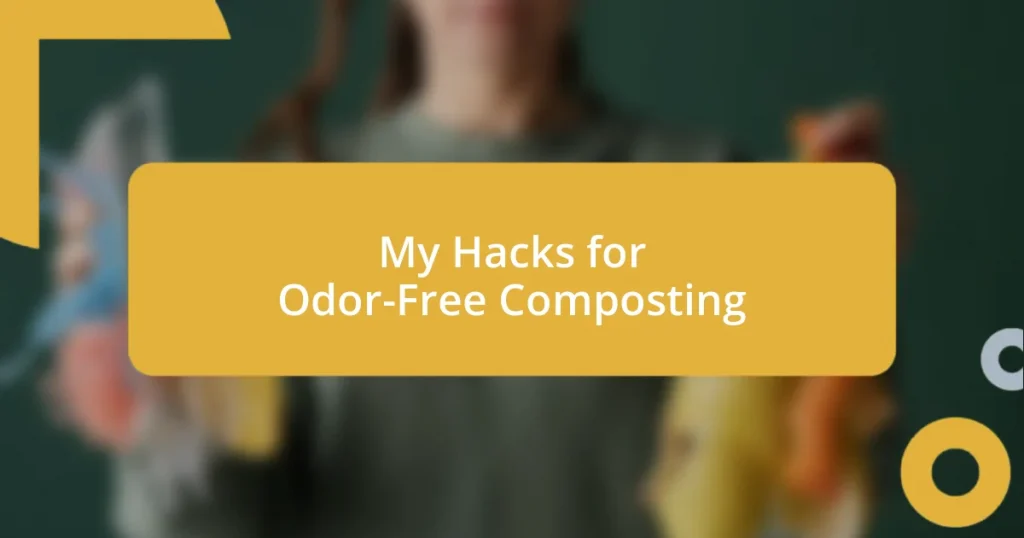Key takeaways:
- The balance between brown (carbon-rich) and green (nitrogen-rich) materials is crucial for successful composting.
- Essential tools like a compost bin, pitchfork, and aerator enhance the composting process and promote faster decomposition.
- Choosing the right compost bin involves factors like size, material, access, aeration, and durability, which significantly affect composting success.
- Regular maintenance and monitoring of moisture levels, along with keeping a composting journal, are vital for a healthy compost pile.

Understanding composting supplies
When I first delved into composting, I was surprised by how essential the right supplies are to the process. Basic supplies like a compost bin or pile, brown materials (like dry leaves), and green materials (like fruit scraps) create the magic that transforms waste into nutrient-rich compost. Have you ever thought about the balance needed between these two categories? It’s fascinating how this ratio affects decomposition.
I remember standing in my backyard, one hand deep in a pile of autumn leaves, marveling at the potential of what I held. I realized that simple items like kitchen scraps or yard waste could become a powerful resource. It truly struck me how composting not only reduces waste but also enriches garden soil, leading to healthier plants and ultimately better food. Doesn’t that make you rethink how you view organic waste?
The right tools can elevate your composting experience as well. Items like a pitchfork for turning the compost or a moisture meter to check dampness can make a significant difference. Have you ever found yourself frustrated by a smelly compost pile? I’ve been there, and trust me, paying attention to your supplies can help prevent a lot of headaches. Embracing the right composting supplies leads not only to a thriving compost pile but also a sense of accomplishment and connection to nature.

Essential composting tools needed
When I started composting, I quickly realized the critical role of essential tools. A sturdy compost bin, for instance, keeps everything organized and contained. Without it, my yard would have looked like a chaotic heap of scraps—a sight that wouldn’t excite anyone about gardening.
Having quality composting supplies, like a pitchfork or a compost thermometer, transforms the entire process. I’ll never forget the first time I turned my compost pile with a pitchfork; it felt like unearthing buried treasure. The rich, earthy aroma that wafted up was nothing short of rewarding. From that moment on, I became even more passionate about the journey of decomposition and the powerful effect it has on my garden.
Another indispensable tool is a compost aerator, which helps maintain airflow and enhances decomposition speed. It may seem like a small addition, but it’s truly a game-changer. I remember being initially skeptical, thinking I could just rely on my pitchfork alone. But once I tried the aerator, I noticed a significant difference in how quickly my compost matured. This personal experience highlighted how the right tools could elevate the composting experience beyond simple waste management.
| Composting Tool | Function |
|---|---|
| Compost Bin | Holds the materials, promoting an organized composting process. |
| Pitchfork | Turns and aerates the compost, speeding up decomposition. |
| Compost Thermometer | Monitors the internal temperature to ensure optimal conditions. |
| Compost Aerator | Enhances airflow within the pile for faster breakdown. |

Choosing the right compost bin
Choosing the right compost bin can feel overwhelming at first, but it’s essential for a successful composting journey. I still remember my excitement when I bought my first compost bin—just the sight of it made me feel like a true gardener! I found that opting for a bin with good ventilation made all the difference. It allowed for better airflow, which is crucial for decomposition.
Here are some key factors to consider when selecting your compost bin:
- Size: Think about how much waste you generate. A larger bin works for big gardens or families, while a smaller one suits urban settings.
- Material: Wooden bins offer natural insulation, while plastic ones are lightweight and easy to clean.
- Access: Look for bins with accessible openings; I chose one with a side door that made scooping out compost a breeze.
- Aeration: Ensure it has holes for airflow; my first bin lacked this and resulted in a smelly mess!
- Durability: Invest in a sturdy bin; I learned that cheap models don’t last through seasons.
Each of these features can enhance your composting experience significantly. Trust me, once you find the right bin, your composting journey will not only become easier, but it will also feel more rewarding as you witness the transformation of waste into rich, fertile soil right in your backyard.

Types of composting materials
The types of composting materials can significantly impact the quality of your compost. I remember the first time I blended kitchen scraps with yard waste. It felt like a culinary adventure, but I quickly learned that not all materials break down at the same rate. For fastest decomposition, aiming for a mix of ‘greens’ and ‘browns’ is essential. Greens—think vegetable peels and coffee grounds—provide nitrogen, while browns, like dry leaves and cardboard, deliver carbon. This balance creates a thriving ecosystem where beneficial microbes love to work.
As I delved deeper into composting, I discovered the importance of choosing the right materials. Some garden enthusiasts might think that throwing everything together is enough, but I learned the hard way that materials like meat and dairy can attract unwanted pests. The excitement of composting turned to frustration when my compost pile became a magnet for critters! It’s vital to stick with safe materials. I’m now a firm believer in adding crushed eggshells, which not only provide calcium but also add variety to the mix.
Another interesting layer to composting materials is the idea of what you can add beyond the kitchen and yard waste. Have you ever considered things like shredded paper or hair clippings? I was initially hesitant to throw in hair, thinking it would feel weird. However, I found that it’s an excellent source of nitrogen, and now I see it as a valuable ingredient. It’s amazing how something seemingly mundane can contribute to such a transformative process. Engaging with various composting materials has not only improved my compost but also deepened my connection to the cycles of nature.

Best suppliers for composting supplies
Finding the right suppliers for composting supplies can elevate your gardening experience immensely. I distinctly remember the day I stumbled upon a local garden center that carried a fantastic range of compost bins, aerators, and even compost thermometers. Knowing where to purchase well-made supplies not only saves time but also ensures that you’re investing in quality products that will last.
For those who prefer online shopping, websites like Amazon or dedicated gardening stores often offer special deals on composting supplies. I’ve found that reading customer reviews is incredibly helpful in determining the best products. One time, I ignored a 1-star review on a compost bin, thinking it wouldn’t happen to me. Surprise, surprise, it did! Learning from others’ experiences can save you from unexpected disappointments.
Don’t overlook local farms or community gardens, either. I love visiting a nearby organic farm that sells composting supplies and, at the same time, shares valuable tips with fellow gardeners. There’s nothing quite like getting firsthand advice from someone who truly understands composting. Plus, supporting local businesses feels great—you’re not just buying a product; you’re participating in a community! So, have you considered the benefits of sourcing your supplies locally? It might just enhance your composting journey even more.

Tips for maintaining compost
To maintain a healthy compost pile, I’ve learned that turning it regularly is key. At first, I was hesitant to disturb my pile, but I discovered that aerating it promotes faster decomposition. I remember the satisfaction of flipping my pile after a week—it felt like uncovering a hidden treasure as I caught the earthy aroma of rich compost wafting up. Have you ever experienced that thrill of hands-on involvement?
Another critical aspect is monitoring moisture levels. I used to think my composters could manage on their own, but I quickly realized they needed my attention. When I touched the pile and it crumbled like a dry sponge, I knew it was time to add some water. Ensuring it’s damp, but not soggy, is essential for fostering microbial activity. It’s like giving your compost a refreshing drink on a hot day!
Lastly, I found that keeping a journal of my composting journey has made all the difference. I jot down what I add, how it smells, and even track the temperature. This reflection helps me notice trends and make informed adjustments. Have you ever thought of documenting your own composting experiences? Trust me—it’s not only rewarding but also helps you improve your techniques over time.

Troubleshooting common composting issues
Sometimes, despite our best efforts, compost piles can attract unwanted odors. I faced this issue when my compost started smelling like rotten eggs. After some investigation, I realized I had too many nitrogen-rich materials without enough carbon sources. Adding dry leaves and shredded paper did wonders! It was like hitting the reset button, and soon the unpleasant smell vanished, replaced by that sweet, earthy scent we all love. Have you ever had that moment of revelation that truly turned things around?
Pests can also become a pesky problem. The first time I found ants crawling through my bin, I felt defeated—like I just couldn’t win. However, a little research showed me that some insects were actually beneficial. But I learned I needed to prevent over-adding sweet or greasy food scraps. Now, I simply bury those scraps deeper in the pile, and what do you know? The ants have dramatically decreased! It’s a simple solution that keeps my compost thriving without the unwanted visitors. What clever tricks have you discovered in your composting journey?
Then there’s the issue of insufficient heat. I remember my shock when I checked my compost thermometer one morning and saw the temperature hovering around room temperature. The thrill of creating ‘hot compost’ can feel like a magical alchemy. Turning the pile and adding more nitrogen-rich greens helped to fuel the microbial activity. It felt incredible to see the thermometer finally rise. Have you ever felt that rush of excitement when your compost gets cooking just right? That’s what keeps me going in my composting adventures!

